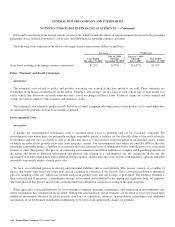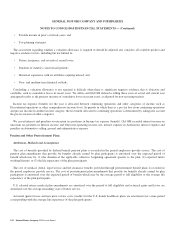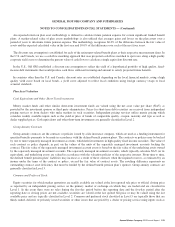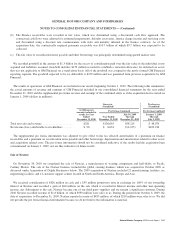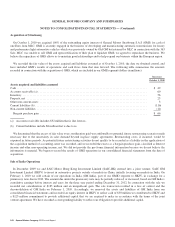General Motors 2010 Annual Report Download - page 161
Download and view the complete annual report
Please find page 161 of the 2010 General Motors annual report below. You can navigate through the pages in the report by either clicking on the pages listed below, or by using the keyword search tool below to find specific information within the annual report.GENERAL MOTORS COMPANY AND SUBSIDIARIES
NOTES TO CONSOLIDATED FINANCIAL STATEMENTS — (Continued)
the activities of a VIE that most significantly affect the entity’s economic performance; and (2) has the obligation to absorb losses of
the entity or the right to receive benefits from the entity that could potentially be significant to the VIE. These amendments also
require, among other considerations, an ongoing reconsideration of the primary beneficiary. In February 2010 the Financial
Accounting Standard Board (FASB) issued guidance that permitted an indefinite deferral of these amendments for entities that have
all the attributes of an investment company or that apply measurement principles consistent with those followed by investment
companies. An entity that qualifies for the deferral will continue to be assessed under the overall guidance on the consolidation of
VIE’s in effect prior to the adoption of these amendments. This deferral was applicable to certain investment companies associated
with our employee benefit plans and investment companies managing investments on behalf of unrelated third parties.
The amendments were adopted prospectively. Upon adoption, we consolidated General Motors Egypt (GM Egypt). Due to our
application of fresh-start reporting on July 10, 2009 and because our investment in GM Egypt was accounted for using the equity
method of accounting, there was no difference between the net assets added to the consolidated balance sheet upon consolidation and
the amount of previously recorded interest in GM Egypt. As a result, there is no cumulative effect of a change in accounting principle
to Accumulated deficit. However, the consolidation of GM Egypt resulted in an increase in Total assets of $254 million, an increase in
Total liabilities of $178 million, and an increase in Noncontrolling interest of $76 million. The effect of these amendments was
measured based on the amount at which the asset, liability and noncontrolling interest would have been carried or recorded in the
consolidated financial statements if these amendments had been effective since inception of our relationship with GM Egypt. Refer to
Note 17 for additional information regarding the effect of the adoption of these amendments.
Transfers of Financial Assets
In January 2010 we adopted certain amendments to ASC 860, “Transfer and Servicing” (ASC 860). ASC 860 eliminated the
concept of a qualifying SPE, establishes a new definition of participating interest that must be met for transfers of portions of financial
assets to be eligible for sale accounting, clarifies and amends the derecognition criteria for a transfer of financial assets to be
accounted for as a sale, and changes the amount that can be recorded as a gain or loss on a transfer accounted for as a sale when
beneficial interests are received by the transferor. The adoption of these amendments did not have an effect on the consolidated
financial statements.
Accounting Standards Not Yet Adopted
In September 2009 the FASB issued Accounting Standard Update (ASU) 2009-13, “Multiple-Deliverable Revenue Arrangements”
(ASU 2009-13). ASU 2009-13 addresses the unit of accounting for multiple-element arrangements. In addition, ASU 2009-13 revises
the method by which consideration is allocated among the units of accounting. Specifically, the overall consideration is allocated to
each deliverable by establishing a selling price for individual deliverables based on a hierarchy of evidence, involving vendor-specific
objective evidence, other third party evidence of the selling price, or the reporting entity’s best estimate of the selling price of
individual deliverables in the arrangement. ASU 2009-13 will be effective prospectively for revenue arrangements entered into or
materially modified in fiscal years beginning on or after June 15, 2010. ASU 2009-13 is not expected to have a material effect on the
consolidated financial statements.
In December 2010, the FASB issued ASU 2010-28, “Intangibles—Goodwill and Other: When to Perform Step 2 of the Goodwill
Impairment Test for Reporting Units with Zero or Negative Carrying Amounts” (ASU 2010-28). The amendments in this ASU
modify Step 1 of the goodwill impairment test for reporting units with zero or negative carrying amounts. For those reporting units, an
entity is required to perform Step 2 of the goodwill impairment test if it is more likely than not that a goodwill impairment exists.
ASU 2010-28 is effective for fiscal years, and interim periods within those years, beginning after December 15, 2010. Any resulting
goodwill impairment is recorded as a cumulative-effect adjustment to beginning Retained earnings (accumulated deficit) in the period
of adoption.
GME has a negative carrying amount; as such, we will apply the provisions of ASU 2010-28 effective January 1, 2011. When a
reduction occurs in the fair-value-to-U.S. GAAP differences attributable to those assets and liabilities that gave rise to goodwill upon
General Motors Company 2010 Annual Report 159



